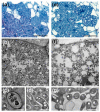A Minimal Genetic Passkey to Unlock Many Legume Doors to Root Nodulation by Rhizobia
- PMID: 32392829
- PMCID: PMC7290934
- DOI: 10.3390/genes11050521
A Minimal Genetic Passkey to Unlock Many Legume Doors to Root Nodulation by Rhizobia
Abstract
On legume crops, formation of developmentally mature nodules is a prerequisite to efficient nitrogen fixation by populations of rhizobial bacteroids established inside nodule cells. Development of root nodules and concomitant microbial colonisation of plant cells are constrained by sets of recognition signals exchanged by infecting rhizobia and their legume hosts, with much of the specificity of symbiotic interactions being determined by the flavonoid cocktails released by legume roots and the strain-specific nodulation factors (NFs) secreted by rhizobia. Hence, much of Sinorhizobium fredii strain NGR234 symbiotic promiscuity was thought to stem from a family of >80 structurally diverse NFs and associated nodulation keys in the form of secreted effector proteins and rhamnose-rich surface polysaccharides. Here, we show instead that a mini-symbiotic plasmid (pMiniSym2) carrying only the nodABCIJ, nodS and nodD1 genes of NGR234 conferred promiscuous nodulation to ANU265, a derivative strain cured of the large symbiotic plasmid pNGR234a. The ANU265::pMiniSym2 transconjugant triggered nodulation responses on 12 of the 22 legumes we tested. On roots of Macroptilium atropurpureum, Leucaena leucocephala and Vigna unguiculata, ANU265::pMiniSym2 formed mature-like nodule and successfully infected nodule cells. While cowpea and siratro responded to nodule colonisation with defence responses that eventually eliminated bacteria, L. leucocephala formed leghemoglobin-containing mature-like nodules inside which the pMiniSym2 transconjugant established persistent intracellular colonies. This data shows seven nodulation genes of NGR234 suffice to trigger nodule formation on roots of many hosts and to establish chronic infections in Leucaena cells.
Keywords: legume-rhizobia symbioses; plant immune responses; symbiotic promiscuity; synthetic replicon.
Conflict of interest statement
The authors declare no conflict of interest. The funders had no role in the design of the study; in the collection, analyses or interpretation of data; in the writing of the manuscript or in the decision to publish the results.
Figures



References
-
- Gresshoff P.M., Hayashi S., Biswas B., Mirzaei S., Indrasumunar A., Reid D., Samuel S., Tollenaere A., van Hameren B., Hastwell A., et al. The value of biodiversity in legume symbiotic nitrogen fixation and nodulation for biofuel and food production. J. Plant Physiol. 2015;172:128–136. doi: 10.1016/j.jplph.2014.05.013. - DOI - PubMed
-
- Roth L.E., Jeon K.W., Stacey G. Homology in endosymbiotic systems: The term ‘symbiosome’. In: Palacios R.A.V.D.P.S., editor. Molecular Genetics of Plant-Microbe Interactions. APS Press; St-Paul, MN, USA: 1988. pp. 220–225.
Publication types
MeSH terms
LinkOut - more resources
Full Text Sources

